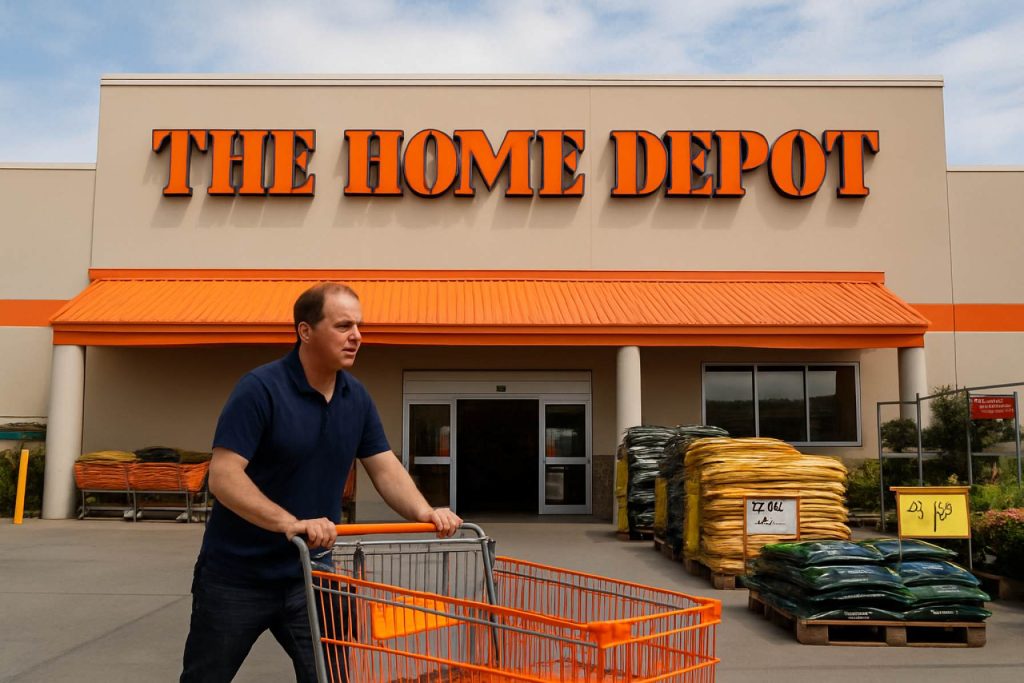
- Home Depot keeps prices stable by relying on a strong domestic supply chain and U.S. manufacturers.
- Early investment in local partnerships and strategic inventory planning shields most products from tariff-related cost hikes.
- Competitors are raising prices due to rising costs of imported goods, but Home Depot’s approach protects its customers.
- A few imported items may still see price increases or be removed, but overall, affordability is maintained on key products.
- Despite a minor earnings shortfall, Home Depot’s sales remain strong, showing resilience in a volatile retail environment.
- The company’s foresight, adaptability, and commitment to supporting local enterprise set a retail industry benchmark.
Aisles bustle with weekend do-it-yourselfers, the scent of lumber and fresh paint thick in the air, but beneath the surface of Home Depot’s orange kingdom, a silent battle is underway. While price tags tick upward across much of America’s retail landscape, Home Depot has chosen a different path—a decision that stuns both competitors and consumers as trade wars ripple through the economy.
How has this retail giant managed the seemingly impossible? By weaving a complex, resilient supply web years before “tariff” became a household word. Over half of Home Depot’s products—think power tools, bathroom fixtures, and myriad screws and bolts—stem from American factories. This deep domestic sourcing, built through proactive partnerships with U.S. manufacturers and strategic inventory planning, shields customers from sudden shocks.
Shoppers at other stores aren’t so lucky. Major chains have bluntly warned of price hikes to counteract the rising costs of imported goods, especially those affected by tariffs targeting certain countries. Shoppers trying to refinish a porch or finally tackle that kitchen renovation can feel the pinch elsewhere—but not so much beneath the Home Depot’s iconic orange sign.
There’s a catch, though. Not every storm can be weathered without a ripple. Select items might still edge up in price, and some highly imported products could quietly exit shelves altogether as profit margins narrow. But for now, the broader strategy keeps most drills, drywall panels, and light fixtures as affordable as possible.
Last quarter, Home Depot narrowly missed earnings forecasts—the first such stumble in four years. Yet the company’s ongoing investment in local suppliers and logistical flexibility paid off: sales figures still surpassed expectations, offering a testament to the brand’s durability in turbulent times.
Step back and a key message emerges. In a world whipsawed by global uncertainty and economic brinkmanship, foresight and adaptability matter. Home Depot’s narrative isn’t just about cost containment—it’s about building enduring connections, fostering local enterprise, and forging a playbook that competitors are now scrambling to emulate.
Takeaway: Stable prices at your local hardware haven aren’t an accident—they’re the result of years of behind-the-scenes planning and a fierce commitment to keeping customers first, no matter what storms are raging beyond the automatic doors.
Why Home Depot’s Pricing Stays Stable While Other Retailers Hike Costs — Expert Insights, Hidden Challenges, and Smart Shopper Tips
Introduction
Home Depot’s ability to hold the line on prices while competitors warn of sticker shock has captured the attention of consumers and industry insiders alike. Beneath the familiar whirr of saws and the iconic orange aprons, Home Depot’s supply chain mastery is redefining how retailers respond to global economic turbulence and trade wars. But what does this innovation mean for shoppers, suppliers, and the future of American retail?
—
Fast Facts & Additional Insights
1. Home Depot’s Domestic Sourcing Strategy Goes Beyond Tariffs
– Over 50% of Home Depot’s merchandise comes from U.S. manufacturers. According to the company’s annual reports and industry analysts at The Motley Fool and CNBC, this is significantly above the average for big-box competitors, many of whom rely far more on international suppliers.
– By cultivating a robust network of domestic vendors, Home Depot reduces its exposure not only to tariffs but also to freight cost fluctuations, port bottlenecks, and international regulatory changes.
2. Supply Chain Digitalization and Automation
– Home Depot has invested billions in supply chain modernization, including AI-driven inventory forecasting, automated distribution centers, and real-time logistics tracking (per Supply Chain Dive and Bloomberg). This infrastructure ensures that inventory gaps are rare and that popular items are restocked faster.
– The company’s 2020-2022 “One Home Depot” initiative included a $1.2 billion outlay for turning regional distribution centers into highly efficient supply chain hubs.
3. Industry Trends and Market Forecasts
– Lowe’s and regional competitors have begun pivoting toward more U.S.-based sourcing, but trail behind Home Depot’s aggressive timeline. According to a 2023 report by Retail Dive, only 30-40% of Lowe’s offerings are U.S.-sourced.
– The global home improvement market is forecasted to grow at a 4.5% CAGR through 2027 (per Grand View Research), but volatility remains a concern due to ongoing geopolitical tensions.
4. Pricing: Features, Specs & Security
– While most core DIY supplies remain stable, specialty imported brands/tools (like rare European hardware or luxury tiles) may see gradual discontinuation or modest price bumps.
– Home Depot’s private-label brands (such as Husky, HDX, and Glacier Bay) play a pivotal role in keeping prices low due to direct manufacturing agreements.
5. Environmental and Sustainability Commitments
– Home Depot is a leader in promoting eco-friendly products with its Eco Options program, offering thousands of goods that meet strict environmental criteria.
– The retailer aims to eliminate expanded polystyrene foam packaging by 2025 and source 100% renewable electricity for its U.S. stores by 2030, according to its 2023 ESG report.
6. Controversies and Limitations
– Some critics, including the Institute for Local Self-Reliance, argue that large-scale sourcing and consolidated distribution models can disadvantage small local businesses and suppliers.
– Not all imported goods are protected: garden decor, exotic woods, and high-end lighting fixtures remain vulnerable to global price swings.
—
Most Pressing Reader Questions: Expert Answers
Q: Will Home Depot’s strategy guarantee low prices in the future?
A: While the domestic focus offers protection, unforeseen global shocks (supply chain crises, natural disasters, trade escalations) could still impact costs. However, Home Depot’s rapid-response logistics and flexible supplier programs mean it can adapt faster than most rivals (per Harvard Business Review analysis).
Q: How does Home Depot compare to Amazon and Lowe’s for price and availability?
A: Amazon may occasionally undercut on certain items, but Home Depot’s in-house brands and in-store pickup often win for immediacy and price transparency. Lowe’s offers similar SKUs, but has a slightly higher percentage of imported goods (source: J.D. Power Home Improvement Retailer Satisfaction Study).
Q: Are there life hacks for saving more at Home Depot?
A: Yes! Consider the following:
– Use the Price Match Guarantee on identical in-stock items.
– Leverage rotating Special Buys and “Pro Xtra” loyalty accounts for discounts.
– Buy in bulk for paint, drywall, or lumber to unlock deeper savings.
– Check clearance sections, especially after season changes.
—
How-To: Smarter Shopping at Home Depot
Step 1: Compare online and in-store pricing; sometimes online-only offers beat shelf prices.
Step 2: Ask store associates about upcoming sales dates or restock times for out-of-stock items.
Step 3: Use Home Depot’s app for barcode scanning—hidden markdowns sometimes appear!
Step 4: Consider private-label alternatives, which balance cost and performance.
Step 5: Sign up for email alerts and mobile notifications for exclusive coupons.
—
Pros & Cons Overview
| Pros | Cons |
|———————————————–|—————————————————|
| Stable pricing on core items | Select imports may become scarce or costlier |
| Rapid restocking due to U.S.-based suppliers | Small/local suppliers may face stiff competition |
| Leading sustainability initiatives | Not all eco-friendly products are cost-competitive|
—
Actionable Recommendations
– DIYers: Stock up on U.S.-made essentials now, especially for long-term projects.
– Pros: Enroll in the Pro Xtra loyalty program to maximize recurring project savings.
– Everyone: Watch for new private-label product launches—usually significantly cheaper than legacy brands.
—
Expert Prediction
As trade tensions and economic uncertainty persist, expect other chains to accelerate their domestic supplier programs—but Home Depot’s head start means it will likely remain the cheapest and most reliable source for the majority of home improvement needs for the next several years.
—
Suggested Related Links
– Home Depot
– Lowe’s
– CNBC
– Bloomberg
—
Conclusion
Home Depot’s steady pricing is no accident—it’s the result of savvy investments, strong domestic partnerships, and continuous innovation. For shoppers, this means more predictable project costs and reliable access to essential materials. Stay alert for evolving deals, embrace private labels, and leverage loyalty programs to stretch your DIY dollar even further.
—
Keywords: Home Depot supply chain, DIY pricing trends, home improvement savings, U.S. manufacturing, retail supply chain strategy



